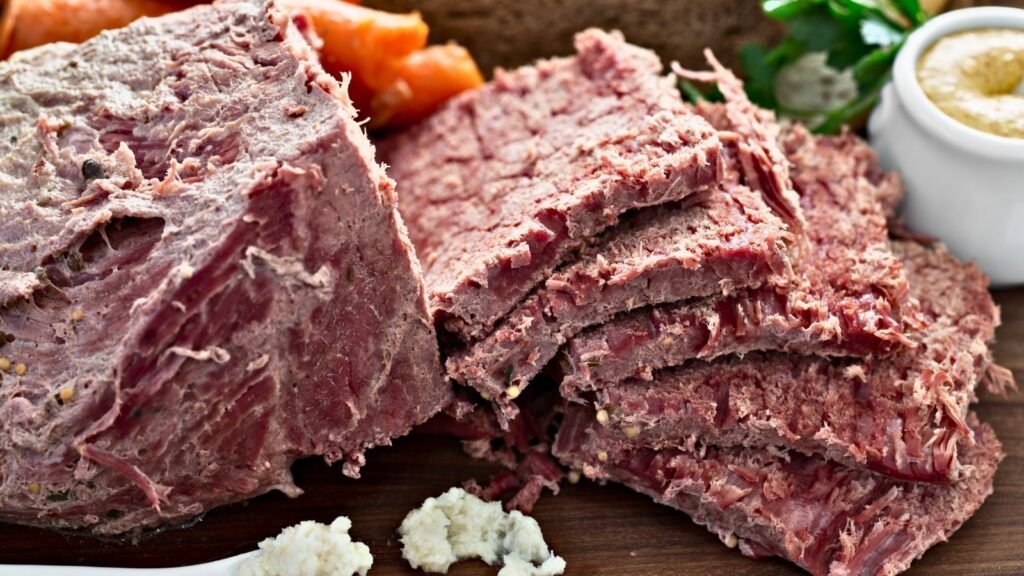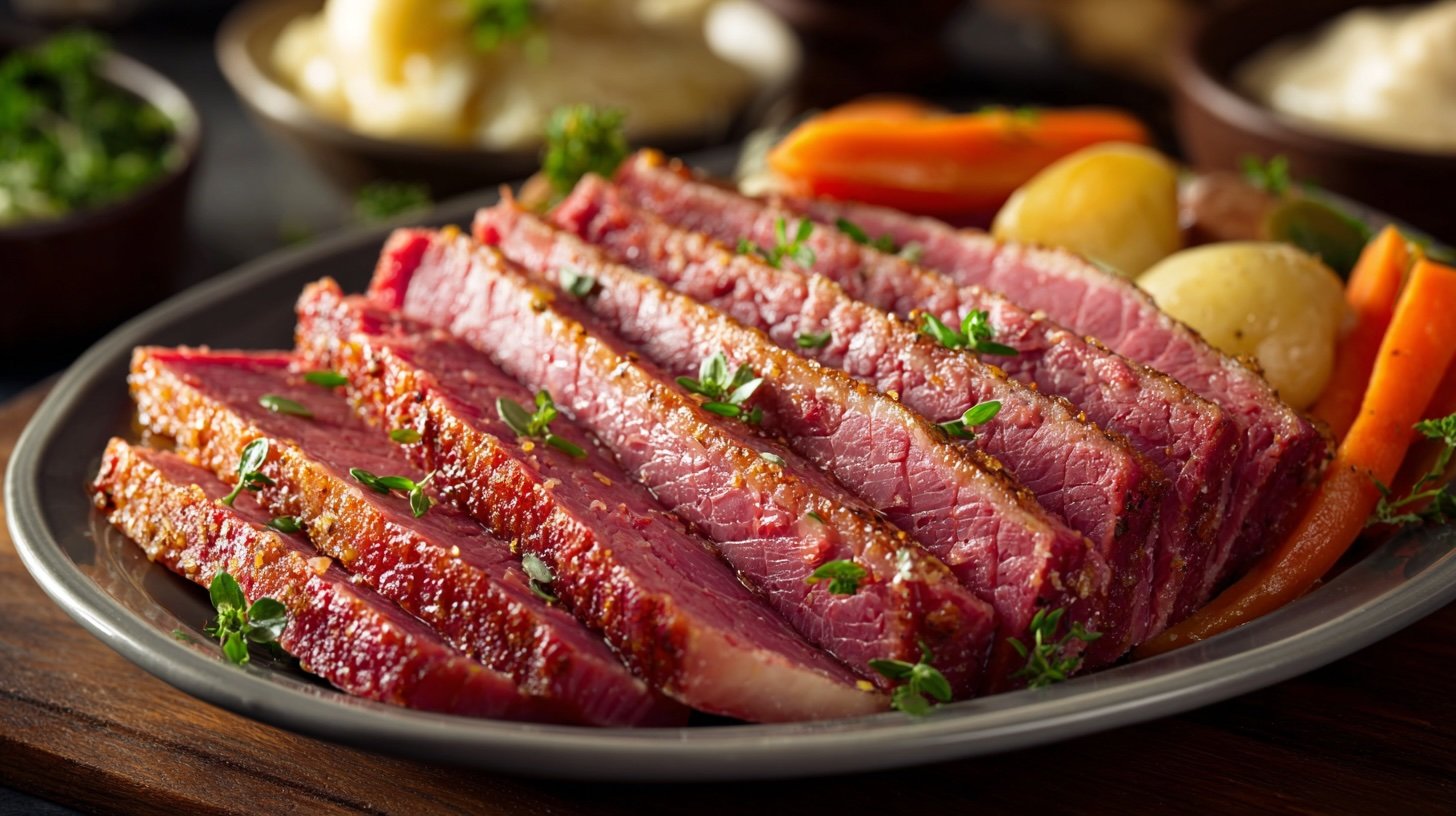No Corn, All Character: The Surprisingly Global Life of Corned Beef
Corned beef is one of those culinary relics that sounds like it should involve sweetcorn but absolutely doesn’t. No kernels, no maize, not even a whiff of popcorn. The “corn” in question refers to the coarse grains of rock salt once used to cure beef long before anyone had a fridge. It’s a survival technique that somehow evolved into comfort food, pub grub, deli culture, and even breakfast in Manila. Not bad for something that started life as a preservation hack.
The story begins with salt. Seventeenth-century Britain was awash with beef but not necessarily with refrigeration, so salting became the preservation method of choice. The big salt crystals were called “corns,” and the process of packing beef with them gave rise to “corned beef.” Ireland became particularly good at it, not because they loved beef so much, but because their salt tax was lower. That meant they could cure beef cheaply and export it in barrels by the ton. Ironically, while the rest of Europe was tucking into Irish corned beef, the average Irish farmer could rarely afford it. Most ate pork instead. History’s sense of humour, once again, did not disappoint.
Things took a twist across the Atlantic. Irish immigrants arriving in America in the 19th century found beef cheaper than it had ever been back home. They adapted their salting traditions and swapped bacon for beef, pairing it with cabbage — the cheapest vegetable around — and accidentally created what we now call the “Irish-American” classic: corned beef and cabbage. The dish, so beloved on St. Patrick’s Day, is about as authentically Irish as the green beer that often accompanies it. Yet it stuck, and now the smell of simmering brisket is as much a part of March as shamrocks and dubious leprechaun hats.

The cut of meat matters. Corned beef almost always begins its journey as a brisket — that chewy, hardworking muscle from the cow’s chest. There are two main cuts: the flat and the point. The flat cut is lean, neat, and slices beautifully for sandwiches. The point is fattier, juicier, and better for those who like their corned beef falling apart. In either case, the process is the same: soak it in brine spiked with salt, sugar, and a carnival of spices — coriander, mustard seeds, cloves, bay leaves, peppercorns. Leave it for days. Then simmer it low and slow until even the most stubborn collagen gives up the fight and melts into tenderness.
That brining stage gives corned beef its signature pink colour, thanks to sodium nitrite, the same preservative used in bacon. Without it, the meat would be grey — which explains why traditionalists insist on the chemical fix, while health-conscious cooks seek out nitrate-free alternatives. You can, in fact, make a naturally cured version using celery juice, which conveniently contains nitrates in disguise. The result looks less bubblegum pink, but your arteries might thank you later.
In Britain, corned beef took on a more down-to-earth role. During the world wars, it became an emblem of ration-era resilience, especially the canned version — that rectangular tin with the key attached to the side, as if opening it were an act of small ceremony. It fed soldiers, builders, miners, and eventually entire post-war households. Out of this came dishes like panackelty — a Northern English casserole layering corned beef with potatoes, onions, and carrots. No Michelin stars required, just a steady hand and a solid appetite.
Across the ocean, Americans had other plans. They took the cured brisket, simmered it into submission, and served it between slices of rye bread with mustard and pickles — the corned beef sandwich was born. Later, the Reuben would elevate it to art form: corned beef, Swiss cheese, sauerkraut, and Russian dressing, grilled until the bread crackled. Across the border in Canada, the Jewish delis of Montreal added smoke to the equation, creating Montreal smoked meat — corned beef’s peppery, aromatic cousin. Less salt-brined, more spice-rubbed, it became a regional religion, particularly at Schwartz’s, where queues still snake out the door.
Meanwhile, the British Empire’s global sprawl meant tinned corned beef travelled too. In the Caribbean, it became “bully beef,” a key ingredient in breakfast hash or with rice and peas. In the Philippines, it turned up as “carne norte,” a sautéed staple often eaten with garlic rice and fried egg. In Guam, Jamaica, Ghana, and even Hong Kong, corned beef took root — cheap, non-perishable, and infinitely adaptable. What started as preservation turned into globalisation on a plate.
For all its history, corned beef has never really gone out of fashion. It just keeps shape-shifting to fit its surroundings. In Detroit, locals invented the corned beef egg roll — brisket, cheese, and sauerkraut deep-fried in a wrapper. In New England, they make a “boiled dinner” — corned beef with root vegetables, often followed by a red flannel hash made from the leftovers. In Scotland, there’s corned beef pie; in Ireland itself, you’ll find corned beef sandwiches in pubs alongside the pints. Somewhere between necessity and nostalgia, corned beef found its forever home.
Of course, modern eaters have started to eye it with suspicion. It’s salty, fatty, and, in its canned form, suspiciously shiny. But the story doesn’t end in guilt. Today’s cooks are reinventing corned beef for a healthier world: leaner brisket cuts, less sodium, more vegetables, and even vegan versions that use seitan or jackfruit to mimic that fibrous, fall-apart texture. You can even find “uncured” corned beef on artisan menus, cured only with natural brines and patience. The irony being that, after centuries of trying to preserve it with everything from rock salt to chemicals, we’ve now come full circle back to simplicity.
Pairing corned beef is an art in itself. The obvious sidekick is cabbage, but roasted root vegetables, mustardy sauces, or horseradish mash elevate it from canteen to comfort. In Jewish delis, you’ll find it with a sour pickle and a cold beer; in Filipino homes, with rice and ketchup; in posh restaurants, maybe reinterpreted as a deconstructed hash under a poached egg. Drinks? Guinness works for tradition’s sake, but a malty ale or even a smoky whisky will do the trick.
Nutritionally speaking, corned beef is a bit of a paradox — high in protein and iron, yes, but also heavy on sodium and saturated fat. The secret is moderation and, ideally, movement. After all, the dockworkers and soldiers who built its reputation weren’t exactly counting calories while swinging crates or fighting wars. Homemade versions let you control the salt content, which feels like reclaiming a small bit of culinary dignity.
Making it from scratch isn’t difficult, only time-consuming. You start with brisket, make a brine with coarse salt, brown sugar, and spices, then soak the meat for five to seven days in the fridge. Flip it occasionally. When ready, rinse it and simmer gently for three hours with aromatics — onions, carrots, bay leaves, peppercorns. Slice across the grain and serve it hot, or chill it and slice thin for sandwiches. Leftovers make divine hash with potatoes and eggs. You’ll never look at the tinned version the same way again.
Corned beef may not have corn, but it has character. It’s a story of survival, migration, adaptation, and nostalgia — a salt-crusted time capsule that somehow still feels relevant. Whether it’s bubbling in a Dublin kitchen, sizzling in a Manila frying pan, or stacked high in a New York deli, it continues to do what it’s always done best: feed people through change. And that, in the end, is a flavour that never goes out of style.
